South Bronx


The South Bronx is an area of the New York City borough of The Bronx. The neighborhoods of Tremont, University Heights, Highbridge, Morrisania, Soundview, Hunts Point, and Castle Hill are sometimes considered part of the South Bronx.
The South Bronx is part of New York's 16th Congressional District, one of the five poorest Congressional Districts in the United States.[1] The South Bronx is served by the NYPD's 40th,[2] 41st,[3] 42nd,[4] 44th,[5] and 48th[6] Precincts.
History
The South Bronx was originally called the Manor of Morrisania, and later Morrisania. It was the private domain of the powerful and aristocratic Morris family, which includes Lewis Morris, signer of the Declaration of Independence, and Gouverneur Morris, penman of the United States Constitution. The Morris memorial is at St. Ann's Church of Morrisania. Morris descendants own land in the South Bronx to this day.
As the Morrises developed their landholdings, an influx of German and Irish immigrants populated the area. Later, the Bronx was considered the "Jewish Borough," and at its peak in 1930 was 49% Jewish.[7] Jews in the South Bronx numbered 364,000 or 57.1% of the total population in the area.[8] The term was first coined in the 1940s by a group of social workers who identified the Bronx's first pocket of poverty, in the Port Morris section, the southernmost section of the Bronx.
1950s: Demographic shift
After World War II, as white flight accelerated and migration of ethnic and racial minorities continued, the South Bronx went from being two-thirds non-Hispanic white in 1950 to being two-thirds black or Puerto Rican in 1960.[9] Originally denoting only Mott Haven and Melrose, the South Bronx extended up to the Cross Bronx Expressway by the 1960s, encompassing Hunts Point, Morrisania, and Highbridge.
1960s: Start of decay
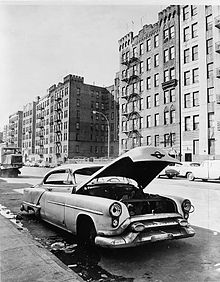
The South Bronx has been historically a place for working class families. Its image as a poverty-ridden area developed in the latter part of the 20th century.[10] There have been several factors contributing to the decay of the South Bronx: white flight, landlord abandonment, changes in economic demographics abandonment, and also the construction of the Cross Bronx Expressway. [11]
The Cross Bronx Expressway, completed in 1963, was a part of Robert Moses’s urban renewal project for New York City. The expressway is ironically, now, known to have been a factor in the extreme urban decay seen by the borough in the 1970s and 1980s. Cutting straight through the heart of the South Bronx, the highway displaced thousands of residents from their homes, as well as several local businesses. The already poor and working-class neighborhoods were at another disadvantage: the decreased property value brought on by their proximity to the Cross Bronx Expressway. The neighborhood of East Tremont, in particular, was completely destroyed by the incursion of the expressway. The combination of increasing vacancy rates and decreased property values caused some neighborhoods to become considered undesirable by homeowners..[11]
In the late 1960s, the area's population began decreasing, commonly thought to be a result of new policies demanding that, for racial balance in schools, children be bused into other districts. Parents who worried about their children attending the demographically adjusted schools often relocated to the suburbs, where this was not a concern. In addition, rent control policies are thought to have contributed to the decline of many middle class neighborhoods in the 1950s and 1960s; New York City's policies regarding rent control gave building owners no motivation to keep up their properties.[12] Therefore, desirable housing options were scarce, and vacancies further increased. In the late 1960s, by the time the city decided to consolidate welfare households in the South Bronx, its vacancy rate was already the highest of any place in the city[citation needed]
1970s: "The Bronx is burning"
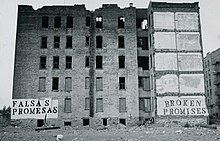
In the 1970s significant poverty reached as far north as Fordham Road. Around this time, the Bronx experienced some of its worst times ever. The media attention brought the South Bronx into common parlance nationwide.
The phrase "The Bronx is burning," attributed to Howard Cosell during a Yankees World Series game in 1977, refers to the arson epidemic caused by the total economic collapse of the South Bronx during the 1970s. During the game, as ABC switched to a generic helicopter shot of the exterior of the old Yankee Stadium, an uncontrolled fire could clearly be seen burning in the ravaged South Bronx surrounding the park.
The early 1970s saw South Bronx property values continue to plummet to record lows. A progressively vicious cycle began where large numbers of high-density multifamily buildings (left vacant by the flight of the white working class to other boroughs) sat abandoned and unsalable for long periods of time, which, coupled with a stagnant economy and an extremely high unemployment rate, produced a strong attraction for criminal elements such as street gangs, which were exploding in number and beginning to support themselves with large scale drug dealing in the area. Abandoned property also attracted large numbers of squatters such as the indigent, drug addicts and the mentally ill, who further lowered the borough's quality of living. As the crisis deepened, in an attempt to help keep property owners from abandoning or defaulting on their property en masse, the city began paying them to house these individuals eligible for free subsidized housing from the city. Although many landlords remaining in the South Bronx were suffering as acutely as their tenants, the city's initial response to the crisis was to treat the remaining white South Bronx property owners as if they were collectively responsible for the situation; responding to calls by civic leaders to punish "slumlords" by lowering the per capita rate for subsidized housing even further, most small owners now found that they could only continue to rent at a loss.[citation needed]
With no hope of reimbursement from the city for maintenance costs and with little legal authority to extract overdue rents or force the eviction of problem tenants, property owners who had waited too long to try and sell their buildings found that almost all of the property in the South Bronx had already been redlined by the banks and insurance companies. Unable to sell their property at any price and facing default on back property taxes and mortgages, landlords began to burn their buildings for their insurance value. Often, the building would be surreptitiously sold off to a "finisher"—a real estate dealer experienced in extracting value from worthless property via insurance fraud—who would have the building stripped of wiring, plumbing, metal fixtures, and anything else of value, often by local residents who specialized in the task. The building would then be burnt and the property insurance claim collected by the finisher. Many finishers became extremely rich buying properties from struggling landlords and burning them; often the properties were still occupied by subsidized tenants or squatters at the time, who were given short or no warning before the building was burnt down and they were forced to move to another slum building, where the process would usually repeat itself. Many residents reported being burnt out of numerous apartment blocks one after the other.
Local South Bronx residents themselves also burned down vacant properties in their own neighborhoods. Much of this was reportedly done by those who had already worked stripping and burning buildings for pay: the ashes of burned down properties could be sifted for salable scrap metal. Other fires were caused by unsafe electrical wiring, fires set indoors for heating, and general mischief. After the establishment of the (then) state-of-the-art Co-op City, Bronx subsidized housing residents, it is alleged, burned down their buildings in an attempt to gain priority status - thereby jumping to the front of the 2- to 3-year-long waiting list for the new units. Some have further alleged that this practice was quietly encouraged (or at least not reported) by city social services and HUD employees in the South Bronx. Firefighters were reported to have shown up to tenement fires only to find all the residents at an address waiting calmly with their possessions already on the curb. [citation needed]
The arson epidemic accelerated throughout the 1970s as crime intensified and nearly all but the poorest residents fled the area, leading to even more arson; by the time of Cosell's 1977 commentary, dozens of buildings were being burnt in the South Bronx every day, sometimes whole blocks at a time and usually far more than the fire department could keep up with, leaving the area perpetually blanketed in a pall of smoke. The local police precincts — already struggling and failing to contain the massive wave of drug and gang crime invading the Bronx — had long since stopped bothering to investigate the fires, as they said there were too many to track. In total, over 40% of the South Bronx's buildings had been burned or abandoned, leaving the appearance of a bombed-out and evacuated European city during the Blitz.[13] During this period, the NYPD's 41st Precinct Station House at 1086 Simpson Street became famously known as Fort Apache, The Bronx as it struggled to deal with the overwhelming surge of crime. By 1980, the 41st's station had been renamed The Little House on the Prairie, as fully 2/3 of the precinct's 94,000 residents had fled and left the station house as the only building on the block that had not been abandoned, burnt by arson, or both.[14]
On Oct. 5, 1977, President Jimmy Carter paid an unscheduled visit to Charlotte Street, while in New York to attend a conference at the United Nations. Charlotte Street at the time was a three-block devastated area of vacant lots and burned-out and abandoned buildings. The street had been so ravaged that part of it had been taken off official city maps in 1974. Carter instructed Patricia Roberts Harris, head of the U.S. Department of Housing and Urban Development, to take steps to salvage the area.[15]
Revitalization and current concerns
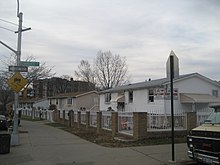
Beginning in the late 1980s, parts of the South Bronx started to experience urban renewal with rehabilitated and brand new residential structures, including both subsidized multifamily town homes and apartment buildings.[16] The Bright Temple A.M.E. Church was listed on the National Register of Historic Places in 1983.[17]
On Charlotte Street, prefabricated ranch-style homes were built in the area in 1985, and the area had changed so significantly that the Bronx borough historian could not locate where Carter had stopped to survey the scene.[15]
The Bronx County Courthouse has secured Landmark status, and efforts are underway to do the same for much of the Grand Concourse, in recognition of the area’s Art Deco architecture. In June 2010, the city Landmarks Preservation Commission gave consideration to establishment of a historic district on the Grand Concourse from 153rd to 167th Street. A final decision was expected in the coming months.[18]
Construction of the new Yankee Stadium has stirred controversy over plans which, along with the new billion dollar field, include new athletic fields, tennis courts, bicycle and walking paths, stores, restaurants as well as a new Metro-North Railroad station, which during baseball season might help ease overcrowding on the subway.[19]
There is hope that these developments also will help to generate residential construction [citation needed]. However, the new park comes at a price: a total of 22 acres (89,000 m2) in Macombs Dam and John Mullaly Parks were sacrificed to build it. Developers say they have plans to create fields on top of parking lots and will replace the old stadium with new parks.[19]
The new stadium was completed in time for the start of the 2009 baseball season. However, the expected completion date of the promised athletic fields and other green space have yet to be revealed. Many in the local community oppose the stadium due to its effects on pollution, traffic, and a massive loss of the community's limited green space.[20]
The population of the South Bronx is currently increasing.[21][22] Strides have been made since the days of arson, the South Bronx is in a real recovery. But it is situated in the poorest congressional district in the country,[1] and contains over half of the Bronx's housing projects. Almost 50% of the population lives below the poverty line. Drug trafficking, gang activity, and prostitution are all still common throughout the South Bronx. Its precincts record high violent crime rates and are all NYPD "impact zones".
Arts and culture

Since the late 1970s the South Bronx has been home to a renewed grassroots art scene. The arts scene that sprouted at the Fashion Moda Gallery, founded by a Viennese artist, Stefan Eins, helped ignite the careers of artists like Keith Haring and Jenny Holzer, and 1980s break dancers like the Rock Steady Crew. It generated enough enthusiasm in the mainstream media for a short while to draw the art world's attention.[24] Modern graffiti is also prominent in the South Bronx. The Bronx is home to many of the fathers of graffiti art such as Tats Cru. The Bronx has a very strong graffiti scene despite the city's crackdown on illegal graffiti. The rise of rap and hip-hop music (and the South Bronx avant-dance band ESG) helped put the South Bronx on the musical map in the early 1980s. The South Bronx is now home to the Bronx Museum of the Arts on the Grand Concourse.[25]
Education
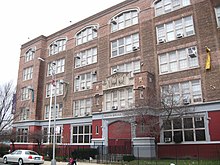
Community School Districts 7, 8, 9 and 12 are approximately within the South Bronx.[26]
Among the public schools are three charter schools, Bronx Success Academy 1 and Bronx Success Academy 2, both associated with the Harlem Success Academy. A new elementary charter school, Academic Leadership Charter School, opened on 141st Street and Cypress Avenue in 2009.
Among the institutions of Higher Education, Hostos Community College of the City University of New York is located in Grand Concourse and 149th Street, ten blocks from the Yankee stadium. www.hostos.cuny.edu
The South Bronx is also home to both for-profit and nonprofit organizations that offer a range of professional training and other educational programs. Per scholas, for example is a nonprofit organization that offers free professional certification training directed towards successfully passing CompTIA A+ and Network+ certification exams as a route to securing jobs and building careers. Per scholas also works with a growing number of Title One South Bronx Middle schools, their students and their families to provide computer training and access.
Transportation
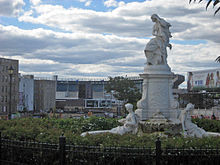
Vehicular: Major Deegan Expressway (I-87); Cross Bronx Expressway (I-95); Bruckner Expressway (I-278); Sheridan Expressway (I-895); Triborough Bridge; Grand Concourse.
Mass transit: The 2, 4, 5, 6, B and D New York City Subway trains all travel through the South Bronx.
A South Bronx Greenway[27] is planned to connect south to Randalls Island and north along the Bronx River.
In 2000, 77.3% of all households in New York's 16th congressional district, covering the South Bronx, did not own automobiles, Citywide, the percentage is 55%.[28]
Notable natives
This section needs additional citations for verification. (March 2008) |
- Joe Moran, Superstar, born and raised in the Morrisaina area
- Danny Aiello, born East Harlem raised on Bergen Ave
- Bobby Darrin, born & raised on Lincoln Ave
- Afrika Bambaataa, current resident of Soundview

- Rapper A.G. of the duo Showbiz and A.G., raised in Mott Haven
- Alex Ramos raised in The Bronx, Professional boxer
- Rapper Armageddon
- Al Pacino, raised in the South Bronx, born in East Harlem
- Aventura Dominican-American bachata music group, formed in The Bronx, New York
- Barry Wellman, raised in Fordham Road near Grand Concourse
- Harold Bloom, writer, literary critic, lived in the South Bronx
- Bernard McGuirk, grew up in the South Bronx
- Majora Carter, raised in, and resident of Hunts Point
- Colin Powell, raised in Hunts Point
- Rapper Cuban Link, born in Cuba, raised in the South Bronx
- Dolph Schayes, raised near East 180th Street and Grand Concourse
- Rapper Drag-On, raised in Soundview
- Rapper Fat Joe, raised in Morrisania
- Grandmaster Flash, current resident of Morrisania
- Harry Gibson
- Rapper Hell Rell, raised in Tremont
- Musician Jimi Hazel of 24-7 Spyz, raised in Mitchell Projects, Mott Haven
- Jennifer Lopez, raised in Castle Hill
- Hip hop pioneer DJ Kool Herc, raised in the Bronx and resides in 220th and Carpenter (Uptown Bronx)
- Rapper KRS-One, originally from Brooklyn, raised in both Mott Haven and Soundview
- Rapper Lord Tariq of the duo Lord Tariq and Peter Gunz, raised in Soundview
- Murray Perahia, concert pianist and conductor, grew up in Walton Avenue
- Charles Nelson Reilly actor, comedian, director and drama teacher, born in The Bronx.
- Rebel Diaz Rebel Diaz is a political hip hop trio out of the Bronx, New York and Chicago

- Ruben Diaz, Jr. Democratic Party politician
- Rapper Remy Ma, raised in Castle Hill
- Scott La Rock Boogie Down Productions, born and raised in The Bronx
- Fr. Stan Fortuna, ordained as a priest in the Bronx in 1990.
- Tim Dog, rapper
- Tom Leykis, radio personality, from Sheridan Ave
- R&B singer Tony Sunshine, raised in Soundview
- Sonia Sotomayor, Associate Justice of the Supreme Court of the United States
- Kerry Washington, actress, grew up on Jackson Avenue
- Willie Colón, salsa musician
- Big Pun, rapper, born and raised in Soundview
- French Montana, rapper, raised in Tremont
- Jordan Bratman, music marketer; born in the South Bronx
- Leonard Susskind, Theoretical Physicist
References
- ^ a b The Tax Foundation - Federal Individual Income Tax Burden by Congressional District, 2004
- ^ 40th Precinct, NYPD.
- ^ 41st Precinct, NYPD.
- ^ 42nd Precinct, NYPD.
- ^ 44th Precinct, NYPD.
- ^ 48th Precinct, NYPD.
- ^ :: Bronx County Clerks Office ::
- ^ Bronx Synagogues - Historical Survey
- ^ Tarver, Denton (2007). "The New Bronx; A Quick History of the Iconic Borough". The Cooperator. Retrieved 17 January 2010.
{{cite news}}: Unknown parameter|month=ignored (help) - ^ http://www.lexisnexis.com/us/lnacademic/auth/checkbrowser.do?ipcounter=1&cookieState=0&rand=0.9697244443316492&bhcp=1
- ^ a b Caro, Robert A. (1974). The Power Broker: Robert Moses and the fall of New York. New York: Knopf. ISBN 0-394-48076-7., p. 893-894
- ^ Cross Bronx Expressway (I-95, I-295 and US 1)
- ^ http://www.demographia.com/db-sbrx-txt.htm
- ^ Fisher, Ian (23 June 1993). "Pulling Out of Fort Apache, the Bronx; New 41st Precinct Station House Leaves Behind Symbol of Community's Past Troubles". New York Times. Retrieved 17 January 2010.
- ^ a b Fernandez, Manny (5 October 2007). "In the Bronx, Blight Gave Way to Renewal". The New York Times. Retrieved 27 March 2011.
- ^ Wynn, Terry (17 January 2005). "South Bronx rises out of the ashes". NBC News. Retrieved 17 January 2010.
- ^ "National Register Information System". National Register of Historic Places. National Park Service. 13 March 2009.
- ^ Dolnick, Sam (22 June 2010). "As Concourse Regains Luster, City Notices". The New York Times. Retrieved 19 March 2011.
- ^ a b http://proquest.umi.com/pqdlink?Ver=1&Exp=12-17-2012&FMT=7&DID=1274048301&RQT=309
- ^ New Yankee stadium
- ^ The (South) Bronx is up: a neighborhood revives"
- ^ SOUTH BRONX RESURRECTION 27 May 2004
- ^ 2007 Fort Greene Park Summer Literary Festival website. See also the Flickr.com photograph album of the 2007 Festival
- ^ Siegal, Nina (27 December 2000). "Hope Is Artists' Medium In a Bronx Neighborhood; Dancers, Painters and Sculptors Head to Hunts Point". New York Times. Retrieved 17 January 2010.
- ^ http://www.bronxmuseum.org/ Bronx Museum website
- ^ To locate a school, see N.Y.C. Department of Education, Find a School (scroll down), as accessed Jun. 1, 2010.
- ^ NYC Economic Development Corp South Bronx Greenway
- ^ "Fact Sheet, Rep. Jose E. Serrano" (PDF). Retrieved 9 April 2011.
Further reading
- Kozol, Jonathan (1995); Amazing Grace; Crown Publishers.
- Berman, Marshall; Berger, Brian, eds. (2007). New York Calling: From Blackout to Bloomberg. Reaktion Books.
- Berman, Marshall (1988). All That Is Solid Melts into Air: The Experience of Modernity. Penguin.
- Gonzalez, Evelyn (2006). The Bronx (Columbia History of Urban Life). Columbia University Press.
- Jensen, Robert, ed. (1979). Devastation/resurrection: the South Bronx. New York: Bronx Museum of the Arts.
- Jonnes, Jill (2002). South Bronx Rising: The Rise, Fall, and Resurrection of an American City. Fordham University Press.
- Office of the Borough President (Bronx, New York City) (1990). Strategic policy statement. New York: Office of the Bronx Borough President.
- Twomey, Bill (2007). The Bronx, in bits and pieces. Bloomington, IN: Rooftop Publishing.
Pictorial works
- Kahane, Lisa (2008). Do Not Give Way To Evil: Photographs of the South Bronx, 1979-1987 (Miss Rosen ed.).
- Twomey, Bill (2002). South Bronx. Charleston, SC: Arcadia. (Pictorial work on historical social life and customs in the South Bronx)
External links

